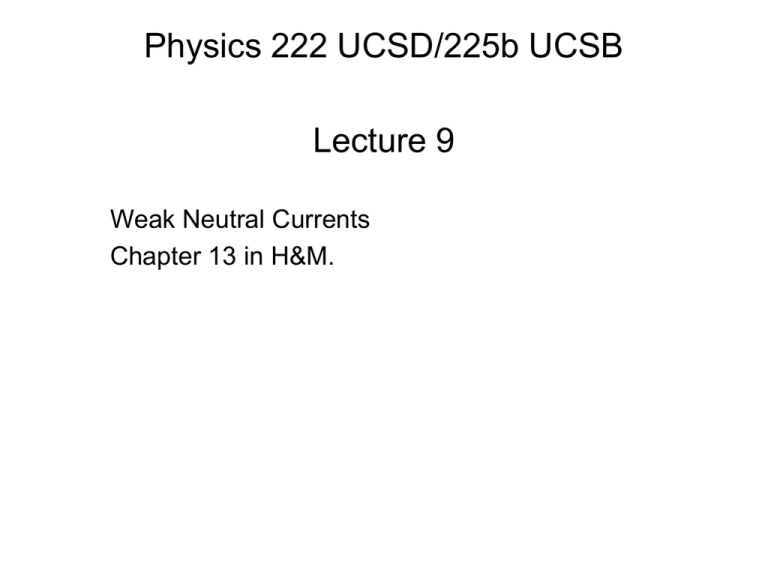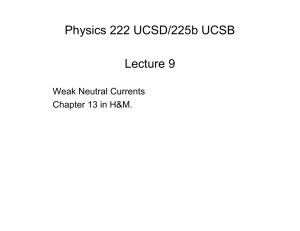Physics 222 UCSD/225b UCSB Lecture 9 Weak Neutral Currents Chapter 13 in H&M.
advertisement

Physics 222 UCSD/225b UCSB Lecture 9 Weak Neutral Currents Chapter 13 in H&M. Weak Neutral Currents • “Observation of neutrino-like interactions without muon or electron in the gargamelle neutrino experiment” Phys.Lett.B46:138-140,1973. • This established weak neutral currents. 4G M 2 J NC J NC 2 1 NC J (q) u cV c A 5 u 2 allows for different coupling from charged current. cv = cA = 1 for neutrinos, but not for quarks. Experimentally: NC has small right handed component. EWK Currents thus far • Charged current is strictly left handed. • EM current has left and right handed component. • NC has left and right handed component. => Try to symmetrize the currents such that we get one SU(2)L triplet that is strictly left-handed, and a singlet. Reminder on Pauli Matrices 0 1 1 0 2 i 1 3 0 1 1 0 i 2 0 0 3 1 0 1 1 (1 i 2 ) 2 0 0 0 0 1 (1 i 2 ) 2 1 0 We will do the same constructions we did last quarter for isospin, using the same formalism. Though, this time, the symmetry operations are identified with a “multiplet of weak currents” . The states are leptons and quarks. Starting with Charged Current • Follow what we know from isospin, to form doublets: 0 1 0 0 L ; ; e L 0 0 1 0 J (x) L L 1 1 1 J (x) L 3 L L L eL eL 2 2 2 3 We thus have a triplet of left handed currents W+,W-,W3 . Hypercharge, T3, and Q • We next take the EM current, and decompose it such as to satisfy: Q = T3 + Y/2 em j 1 Y J j 2 3 • The symmetry group is thus: SU(2)L x U(1)Y • And the generator of Y must commute with the generators Ti, i=1,2,3 of SU(2)L . • All members of a weak isospin multiplet thus have the same eigenvalues for Y. Resulting Quantum Numbers Lepton T T3 Q Y 1/2 1/2 0 -1 e -L 1/2 -1/2 -1 -1 e -R 0 0 -1 -2 Quark uL dL uR dR T 1/2 1/2 0 0 T3 1/2 -1/2 0 0 Q 2/3 -1/3 2/3 -1/3 Note the difference in Y quantum numbers for left and right handed fermions of the same flavor. You get to verify the quark quantum numbers in HW3. Y 1/3 1/3 4/3 -2/3 Now back to the currents • Based on the group theory generators, we have a triplet of W currents for SU(2)L and a singlet “B” neutral current for U(1)Y . Basic EWK interaction: g Y igJ W i J B 2 i i • The two neutral currents B and W3 can, and do mix to give us the mass eigenstates of photon and Z boson. W3 and B mixing • The physical photon and Z are obtained as: 3 A W sin W B cos W Z W 3 cosW B sin W • And the neutral interaction as a whole becomes: g Y 3 3 igJ W i J B 2 Y J igsin W J 3 gcosW A 2 Y J igcos W J 3 gsin W Z 2 Constraints from EM ej em Y Y J J eJ 3 igsin W J 3 gcos W 2 2 gsin W gcos W e sin W g g cosW We now eliminate g’ and write the weak NC interaction as: g g 3 2 em NC i J sin j Z i J W Z cosW cosW Summary on Neutral Currents 1 Y j J j 2 NC 3 2 em J J sin W j em 3 This thus re-expresses the “physical” currents for photon and Z in form of the “fundamental” symmetries. Vertex Factors: ieQ f Charge of fermion g 1 f f 5 i (cV c A ) cosW 2 cV and cA differ according to Quantum numbers of fermions. Q, cV,cA fermion Q cA cV neutrino 0 1/2 1/2 e,mu -1 -1/2 -1/2 + 2 sin2W ~ -0.03 u,c,t +2/3 1/2 1/2 - 4/3 sin2W ~ 0.19 d,s,b -1/3 -1/2 -1/2 + 2/3 sin2W ~ -0.34 Accordingly, the coupling of the Z is sensitive to sin2W . You will verify this as part of HW3. Origin of these values The neutral current weak interaction is given by: 1 g 5 3 2 i f (1 )T sin W Q f Z 2 cosW Comparing this with: Leeds to: g 1 f f 5 i (cV c A ) cosW 2 c T 2Q f sin W f V c T f A 3 f 3 f 2 Effective Currents • In Chapter 12 of H&M, we discussed effective currents leading to matrix elements of the form: 4G *T J J 2 G g2 2 8M 2 W M CC 4G 2 J NC J NC *T 2 G g2 2 2 8M cos W 2 Z M NC From this we get the relative strength of NC vs CC: 2 M 2 W2 M Z cos W EWK Feynman Rules Photon vertex: ieQ f Z vertex: g 1 i (cVf c Af 5 ) cosW 2 W vertex: g 1 i (1 5 ) 2 2 Chapter 14 Outline • Reminder of Lagrangian formalism – Lagrange density in field theory • Aside on how Feynman rules are derived from Lagrange density. • Reminder of Noether’s theorem • Local Phase Symmetry of Lagrange Density leads to the interaction terms, and thus a massless boson propagator. – Philosophically pleasing … – … and require to keep theory renormalizable. • Higgs mechanism to give mass to boson propagator. Reminder of Lagrange Formalism • In classical mechanics the particle equations of motion can be obtained from the Lagrange equation: d L L 0 dt qÝ q • The Lagrangian in classical mechanics is given by: L = T - V = Ekinetic - Epotential Lagrangian in Field Theory • We go from the generalized discrete coordinates qi(t) to continuous fields (x,t), and thus a Lagrange density, and covariant derivatives: L(q, qÝ,t) L(, , x ) d L L L L 0 0 dt qÝ q x ( ) Let’s look at examples (1) • Klein-Gordon Equation: L L 0 x ( ) 1 1 2 2 L m 2 2 2 m 0 Note: This works just as well for the Dirac equation. See H&M. Let’s look at examples (2) Maxwell Equation: L L ( A ) A 0 1 => L F F j A 4 L j A L 1 A A A A ( A ) ( A ) 4 F j 2 1 1 g g A A A 2 A A 2 ( A ) 2 F Aside on current conservation • From this result we can conclude that the EM current is conserved: F F j A A A A ( A A ) 0 • Where I used: A A Aside on mass term • If we added a mass term to allow for a massive photon field, we’d get: ( m )A j 2 This is easily shown from what we have done. Leave it to you as an exercise.




